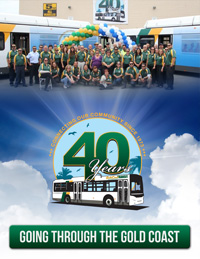
Going Through the Gold Coast

The 18th Century Author and Anglican Priest Laurence Sterne once wrote, “So much of motion is so much of life, and so much of joy…†For one enterprise in Southern California,  much of the joy this July comes from celebrating a 40th Anniversary of services that have not only supported so much of life, but also, indeed, so much of motion.
This year marks the 40th Anniversary of Gold Coast Transit, the public transportation bus service crucial to commuters throughout the Southern California community of Oxnard as well as the surrounding areas of western Ventura County. Established in 1973 as a joint powers authority emerging from an agreement between the communities of Ojai, Oxnard, Port Hueneme, San Buenaventura and the County of Ventura, it was initially known as South Coast Area Transit (or SCAT). In 2007, following an acquisition of 26 new buses, leadership determined it was a good time to rebrand the enterprise in a way that was more suitably aligned with the region’s historic recognition as the Gold Coast. While its name was transitioned to Gold Coast Transit, what is more important is that this service has been critical to the transit needs of millions of people. In fact, last year more than three and a half million passengers relied on this service. General Manager Steve Brown says that number includes riders of all types: students who attend two area colleges, seniors en route to medical appointments and employees who use the service to get to work. Gold Coast Transit additionally helps connect passengers to the inter-county transit service known as VISTA, with routes that connect areas such as eastern Ventura County, Santa Barbara and Los Angeles.
Brown says that, with the increasing costs of gas, GCT has seen an increasing number of riders who choose to take transit rather than driving their own vehicle, and he anticipates transporting 3.6 million passengers this year. GCT has developed programs that uniquely cater to particular groups of riders. For example, ACCESS is a special origin-to-destination dial-a-ride public transit service for those 65 years and older, as well as those who have disabilities which prevent their use of the fixed-route service. Throughout the GCT service area, ACCESS accommodates trips to any location, and connections can be made to similar transit services in other parts of the County… Riders typically reserve their trip one day in advance, but can be picked-up from their home and transported to a desired location. Vehicles are equipped with wheelchair lifts, and, while drivers provide help with boarding and alighting, personal care attendants can also ride along to provide assistance to passengers who need it.
More schools are increasingly relying on GCT services for field trips to help students expand their learning horizons. Â Students are able to learn more about using public transit in the process. Teachers who contact Gold Coast Transit’s Customer Service Team will find staff prepared to help plan a customized itinerary tailored to their individual trip needs. A variety of businesses also rely on Gold Coast Transit as a cost-effect advertising medium. Its fleet of 54 buses, each a moving billboard, contain advertisements that reach more than 300,000 area residents, every day of the year. Buses are daily traversing distances that roughly equate to more than two million miles per year. That constitutes a lot of market coverage at prices significantly less than what other mediums cost.
Efficient & Eco-Sensitive
Air quality has been a long concern in California, but for that matter, the quality of the state’s economy has also prompted concern. In both respects, its operational processes add certain luster to Gold Coast Transit. More than 18 years ago, long before many municipalities throughout the nation, GCT converted to compressed natural gas vehicles. While these vehicles are safer for the environment due to having cleaner fuel emissions, they’re also much cheaper to fuel than more conventional vehicles. GCT maintains its own fueling station on-site, and as Brown says, “CNG has been a huge benefit for us because it is very cheap … when I see diesel fuel reach prices of more than $4.20 per gallon; I get really happy that we’re using compressed natural gas.â€
He adds that GCT has taken advantage of federal congestion mitigation air quality grants to add new routes to its service area. These routes have been strategically developed to reduce traffic congestion, thereby reducing exhaust emissions, but also provide transit service to areas which previously lacked. This too has led to increased ridership, especially for those in South Oxnard who are connecting with jobs or the Ventura County Government Center on the other side of town.
It terms of efficiency and convenience, GCT has recently implemented new electronic fare boxes within its fleet. In the past, passenger purchased passes which had to be verified by drivers, but now, the system enables passenger to quickly swipe a card through a reader which beeps when the fare is verified. Brown says it allows for more rapid boarding. GCT is additionally developing new fare models that will allow passengers to purchase day passes on the bus, or purchase monthly passes that are good for 31 days from the point of purchase, as opposed to former methodology that required monthly passes to be purchased at the start of each month. The new electronic fare boxes will additionally aid in managing the new fare models.
GCT has traditionally been proactive in its incorporation of technology. For example, each of its buses is equipped with as many as eight cameras, which record what happens on the bus as well as around the exterior of the bus. Brown says these systems have not only been helpful in a variety of cases. In one, a bus driver was stopped at an intersection watching the car in front of him make a left turn. At the same time, a car from the opposite direction ran the red light striking the car that was turning. Police were able to determine who was at fault because the bus cameras had recorded the entire incident. Brown says such occasions like that are rare, and most days, the cameras are simply a means of monitoring operations and verifying operational quality. GCT’s efficiency and eco-sensitive standards are ultimately expressions of a larger mission statement which mandates the providing of “safe, responsive, convenient, efficient, and environmentally responsible public transportation that serves the diverse needs of our community.â€
Future Improvement
Beyond the celebrations planned for this 40th anniversary year, Brown is also enthusiastic about certain golden opportunities for Gold Coast Transit to grow. While many transit authorities have costs offset by local tax revenue, Ventura County is the state’s largest which doesn’t have a local sales tax to support transportation. Currently, there is legislation seeking to create a special Gold Coast Transit district. This would enable GCT to better plan and expand on services, but also utilize local revenues to leverage sources of federal funding. That legislation has yet to undergo full passage, but Brown says he is encouraged by the support it has received.
He is also encouraged about plans to establish a new service center and operational base. At present, GCT occupies a three-acre site which has employees sharing parking spaces with the buses. On a nightly basis, as buses return to the center, staff often has to go out and move their personal vehicles to accommodate bus parking. Brown says a 15-acre site has been identified, two miles from their current location, which is also close in proximity to the main CNG transmission line GCT uses for fuel. Some $25 million in funding has been lined-up to design and build the facility and Brown says those efforts will not only lead to new jobs, but allow for operational improvements and further growth.
While GCT’s anniversary has prompted celebration, which includes buses being decked out with images from the last forty years and passengers sharing testimonies of their experiences and service interactions with drivers, Brown says all are equally focused on the next forty years, and beyond. Increasing gas costs, along with increasing demand for convenience and quality service, will lead to new generations of riders. As this occurs, Gold Coast Transit will continue to focus on the safety of its passengers as well as the safety of the environment in which it operates, while also developing routes and special programs that cater to the community, effectively enabling those of the Gold Coast, to stay on-the go.
 For more information, please visit their website at:  Gold Coast Transit
Preferred Vendors of Choice:








